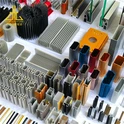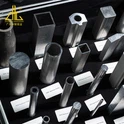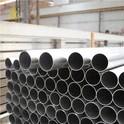In recent years, with the rapid development of China's large-scale infrastructure investment and industrialization process, the output and consumption of the aluminum profile industry have increased rapidly, and China has become the largest aluminum profile production base and consumer market in the world. After nearly ten years of rapid growth, the Chinese aluminum profile industry has entered a new development stage and presented many new development trends.

The application prospect of the industrial aluminum profile is remarkable
In terms of global production and sales of aluminum profiles, from the perspective of production capacity distribution, in 2019, there were about 95 countries and regions in the world that could produce aluminum profiles with more than 2,200 production enterprises. It was noteworthy that China's production capacity accounted for more than 50% of the world's total production capacity, ranking first.
With the growth of the global economy and the continuous expansion application of aluminum extrusions, the global consumption of aluminum extrusions increased from about 18.69 million tons in 2011 to 45.5 million tons in 2021, with a compound annual growth rate of 17.5%. It is expected that the global consumption of aluminum extrusions to reach about 56.69 million tonnes in 2022.
From the perspective of regions, the consumption in major regions of the world showed different trends from 2011 to 2021, with the proportion of Chinese consumption rising rapidly, while Europe and North America showed a downward trend. By 2021, China's consumption will account for 47% of global consumption, while Europe, North America, and Japan only account for 21%, 8%, and 6%, respectively. Our country has developed into a big consumer country for aluminum profile.
In the industrial field, at present, China's industrial aluminum profiles account for about 30% of the total application of aluminum profiles. It is mainly applicable to the transportation industry (including the automobile and rail transportation industry), equipment and machinery manufacturing industry, and consumer durables industry (including the light industry), accounting for about 10%, 10%, and 12% of China's aluminum profiles, respectively. In the same period of Europe, North America, and Japan's aluminum profile consumption structure, the proportion of industrial consumption reached 60%, 55%, and 40%, respectively, much higher than in China. The difference in consumption structure reflects the lack of production, development, and application of the Chinese aluminum profile in the industrial field, and also indicates the huge growth space of Chinese industrial aluminum profile consumption.
It is expected that in the next 5~10 years, the consumption of industrial aluminum profile will continue to increase, and the proportion of aluminum profile products will increase from about 30% to about 45-50% in 2025. According to the government's plan, in the next ten years, industrial materials will account for nearly 70% of the total use of aluminum.
More importantly, the development of industrial aluminum profiles for enterprises to win rich economic benefits and social value. Nowadays, the production and sales costs of building profiles are more transparent, and the added value of products is not high. However, industrial profiles can increase the profit margin of enterprises by at least 20% ~ 30%. In addition, because of its low carbon environmental protection in the production process, in line with the national energy saving and emission reduction and lightweight development of the aluminum industry mission.

National policies support the development of the aluminum industry
In the next few years, the consumption of industrial aluminum profiles will rapidly grow, and medium and high-end products will become mainstream. As a developing country in the middle of industrialization, the next 20 to 30 years will be a key period for stepping into the middle-developed country and realizing the third strategic goal. The aluminum profile has a huge application space in the industrial field. In China's existing 124 industrial sectors, 113 departments use aluminum products, accounting for 91% of the total.
Given the current situation that the proportion of industrial aluminum profile in the whole aluminum profile products is too low, the relevant national departments have put forward guidance opinions on the consumption structure of aluminum profile.
At the same time, with the development of lightweight in the transportation, electronic power industry, and machinery manufacturing industry, the industrial application field of the aluminum profile has been widened, and the demand for medium and high-strength aluminum profiles and tube rods is growing rapidly. In the next few years, the proportion of industrial aluminum profile consumption in the total consumption of aluminum profile will increase year by year, and the proportion of aluminum profile products will rise from about 30% at present to about 45-50% in 2025, gradually occupying a dominant position in the market.
Because aluminum products have the characteristics of lightweight, low price, and recyclability, under the premise of the national emphasis on energy saving and environmental protection, aluminum profiles in the fields of transportation, home appliances, electronics, and mechanical equipment in the future market are very huge.
Taking an automobile as an example, it is estimated that if the body weight of an automobile is reduced by 10%, fuel consumption can be reduced by 6-8%. Aluminum products are undoubtedly the best material for automobile weight reduction. According to Alcoa's research data, using aluminum instead of steel to reduce the weight of 500,000 buses by one ton would save 2.4 billion liters of fuel. It would also dramatically reduce greenhouse gas emissions. Nowadays, the global average amount of aluminum used in automobiles has risen from 50 kg/vehicle in early 1980 to 107 kg/vehicle, an increase of 1.14 times. According to the European Aluminum Association, the amount of aluminum used in cars in Europe is expected to reach 300 kilograms per vehicle by 2025.
In addition, China's new energy and environmental protection industry is growing at an average annual rate of more than 20%. Among the most widely used industries are solar energy and LED, and aluminum profiles are gradually widely used in these industries due to their advantages of good thermal conductivity and lightweight.

Technological innovation has become the new direction of the industry
With the national industrial policy, the adjustment of industrial structure, and the improvement of consumers' requirements for product quality, the low-added value of the aluminum processing industry has gradually changed. In the future, the internal integration of the industry will continue to increase. Some enterprises whose products are positioned in the low and medium market and whose production technology and equipment technology are backward will face pressure from the market, capital, cost, energy consumption, technology, and other aspects. Some enterprises with leading production technology, excellent quality, market-oriented, strong innovation ability, and advanced management will occupy more market shares.
With the integration of the industry, the reorganization and merger of aluminum profile enterprises will be accelerated. And the enterprises will develop toward the direction of collectivization, large-scale, specialization, and branding. The comprehensive strength of product technology development, quality management, sales, and service has become a key factor for enterprises to grow bigger and stronger.









